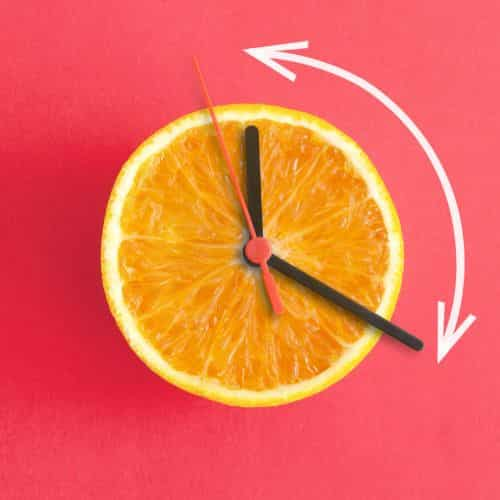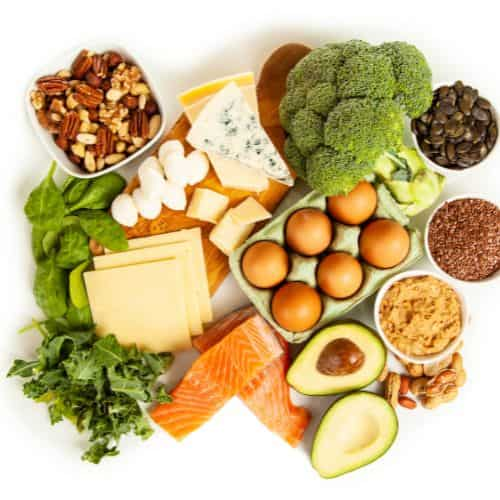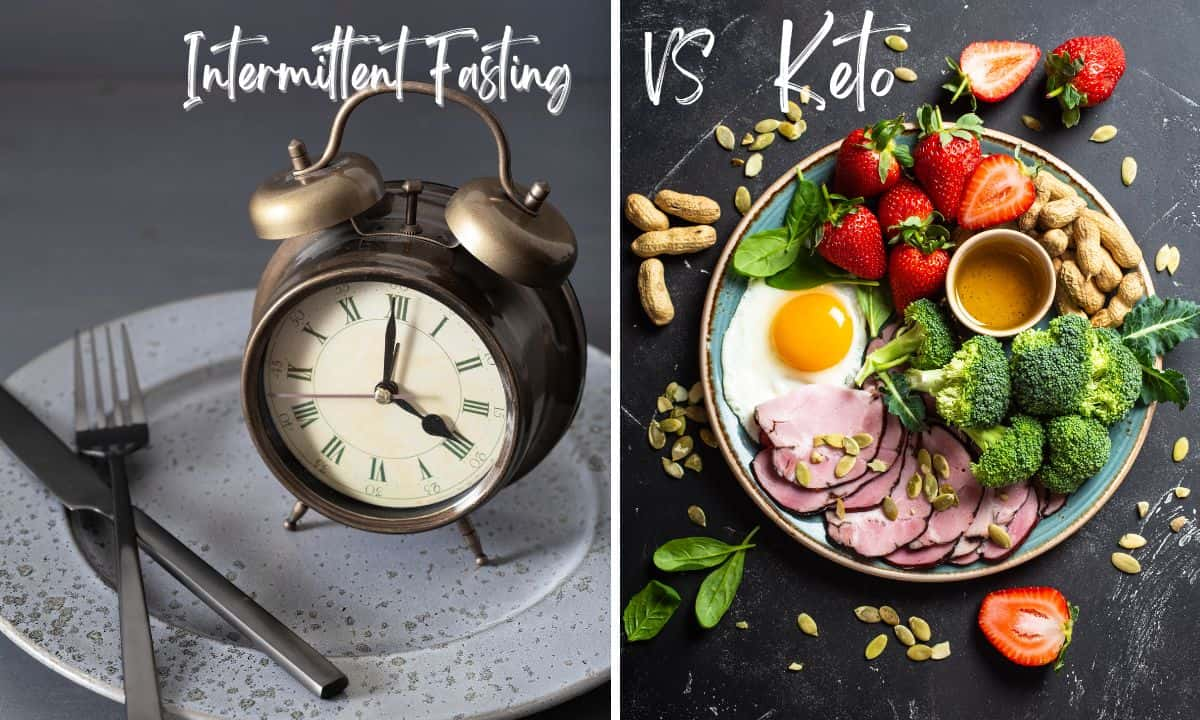Keto vs Intermittent Fasting [The Dietitian Weighs In]
You’ve probably heard about both intermittent fasting and keto, but maybe you’re unsure which one is right for you.
Table of Contents
ToggleFirst off, let’s discuss the obvious differences. Then, we will look at what science and nutrition experts say about the two diets.
The Big Picture: Keto vs Intermittent Fasting
Intermittent fasting focuses solely on when to eat and when to abstain from food for certain periods of time. Keto focuses on what to eat without any restrictions on when to eat.
Keto is a high-fat diet that restricts your carb intake.
What is Intermittent Fasting (IF)?

IF is a pattern of eating in which you alternate between periods of fasting and periods of eating. One of the most common forms is 16/8 (16 hours of fasting, 8 hours of eating).
Conveniently, the fasting and eating times can be adjusted to suit individual needs. It’s important to note that IF does not specify what foods to eat but rather when you should eat them.
During the fasting period, you may consume water, tea, black coffee, and other non-caloric beverages. There are no restrictions on the types of food you can have during eating periods.
Other popular intermittent fasting schedules are:
Types of Intermittent Fasting
| Plan | Eating window | Fasting window | Examples |
| Time-restricted eating | 1-9 hours | 15-23 hours | 16:8, 8:16, 15:9 |
| Alternate-day fasting | Anytime during the eating days | The every-other-day diet | The every other day diet |
| Whole-day fasting | Anytime during the eating days | Limit to 500 calories during fasting days | 5:2 |
16:8 Method
This is the most popular method. You fast for 16 hours and have an 8-hour eating window. This type of IF is easy to stick to as it follows a natural eating pattern.
For example, you could eat your first meal at 11 am and finish your last meal before 7 pm.
During the eating period, you can have anything you want. During the fasting period, on the other hand, you can only drink zero-calorie liquids such as water and coffee or tea without milk.
15:9 Method
In this IF version, you fast for 15 hours and have a 9-hour eating window.
18:6 Method
In this stricter IF method, the fasting window is 18 hours, and the eating window is 6 hours.
Whole-Day Fasting
5:2 Intermittent Fasting
On two non-consecutive days of the week, you only eat 500 calories. For the other 5 days, you eat what you normally would, whenever you normally would.
Alternate-Day Fasting
Similar to the 5:2 method, during fasting days you eat no more than 500 calories, and there are no restrictions during eating days.
The difference is that you alternate between fasting and eating days.
What Foods Can You Eat in Intermittent Fasting?
In general, you can eat whatever you like during the eating window.
However, it’s important to note that the quality of food matters. Eating nutrient-dense foods is essential, as that will ensure you are getting the vitamins, minerals, and other important nutrients your body needs for good health.
Sample Intermittent Fasting Schedule
The schedule will depend on the IF method you choose.
Example: 16:8 IF Method
| Early eating window | Midday eating window | Late eating window | |
| First meal | 8:00 am | 11:00 am | 1:00 pm |
| Last meal | 4:00 pm | 7:00 pm | 9:00 pm |
These are just examples; you can choose any schedule that works with your lifestyle.
What is the Keto Diet?

The keto (ketogenic) diet focuses on micronutrients. It’s a very low-carb, high-fat diet that helps the body reach ketosis.
When carb intake is drastically reduced and fat intake increases, your body will enter a metabolic state called ketosis. This means your body uses fat instead of glucose (carbohydrates) as its primary fuel source.
A typical keto diet comprises 70-80% fat, 10-20% protein, and 5-10% carbohydrates.
In keeping with the low-carbohydrate approach of this diet, followers usually consume only 20 to 50 grams of carbohydrates on a daily basis. To make it easier to visualize, that’s equivalent to only two pieces of fruit or ¾ cup of cooked oatmeal.
What Foods Can You Eat on the Keto Diet?
| Meat | Beef, chicken, turkey, veal, buffalo meat, etc |
| Cured meats | Bacon, sausage, ham, etc |
| Fish and Seafood | Salmon, tuna, trout, mackerel, shrimp, scallops, octopus, calamari, etc |
| Eggs | Eggs, egg products and foods made with eggs |
| Cheese | Unprocessed cheese like cheddar and mozzarella, cream cheese |
| Fats | Butter, cream, ghee, lard, etc |
| Oils | Coconut oil, olive oil, grape-seed oil, avocado oil |
| Avocados | All types |
| Nuts | Almonds, brazil nuts, walnuts, peanuts, etc |
| Seeds | Chia, sesame, flax, pumpkin, etc |
| Vegetables | All low-carb types: leafy greens, tomatoes, onions, peppers, etc |
| Condiments | Salt, pepper, herbs, and spices |
What Foods Do You Need to Limit in the Ketogenic Diet?
This dietary program’s key factor is achieving the recommended macronutrient levels. To achieve ketosis, you must reduce your intake of sugar and carbs.
| Foods High in Sugar | Cookies, ice cream, cake, candy, jam, jelly, and other preserves with added sugar, canned fruit packed in sugar, pastries, donuts, milkshakes, and most ready-to-eat cereals |
| Sugary beverages | Soda, energy drinks, fruit juice, etc |
| Grains | Bread, rice, pasta, cereal, and all types of grains |
| Fruits | All, except small portions of berries |
| Beans and legumes | Black beans, kidney beans, lentils, peas, chickpeas, and all other beans and legumes |
| Root vegetables | Potatoes, malanga, sweet potatoes, carrots, and other root vegetables |
| Condiments with added sugar | Barbecue sauce, ketchup, honey mustard, teriyaki sauce, etc |
| Alcohol | Beer, wine, mixed drinks |
Sample Meal Plan
Breakfast
- Avocado toast made with keto bread and topped with eggs.
- Keto pancakes
Lunch
Dinner
Alcohol
Following this diet does not mean you have to give up alcohol entirely—the key is to select beverages that contain minimal amounts of carbohydrates. This includes gin, tequila, rum, whiskey, and vodka.
If you like cocktails, you can make keto-friendly drinks by using low-carb mixers.
Intermittent Fasting vs Keto
Which One is Easier to Follow?
Both are reasonably easy to follow. Intermittent fasting is simpler in terms of the diet itself since no food-specific rules apply. Keto can be more complicated due to the need to count macronutrients and avoid certain foods.
Intermittent fasting typically requires a larger time commitment than keto, but this will depend on preference and lifestyle.
Keto has the benefit that once the body enters ketosis and becomes adapted to it, you will likely experience fewer cravings.
Ultimately, both diets have potential health benefits and can help with weight loss. Choosing one over the other will depend on individual preferences, lifestyles, and goals.
You can even combine both regimens.
Weight Loss
Intermittent Fasting

Technology has changed the way people act at night. Often, as people are binge-watching on-demand series or movies, they are also snacking. So there’s no surprise that people eat more calories than they burn.
IF limits the amount of snacking at nighttime, thus reducing the overall number of calories. While it is possible to compensate by eating more during the day, it’s not as common.
Furthermore, IF can benefit insulin levels during fasting hours, facilitating fat use for energy and weight loss.
A 2020 review of 27 studies found that people following intermittent fasting lost between 0.8% to 13% of their initial body weight, even over relatively short periods of time.
Keto
Research shows that the ketogenic diet is effective for achieving quick weight loss. People following the keto diet can lose 10 pounds in only two weeks.
A review of studies shows the average weight loss of participants following the keto diet was 17.15 lbs in participants with diabetes and 7.45 lbs in those without diabetes.
What’s more, all-important muscle mass is maintained when using this weight-loss method, which is particularly vital for individuals above the age of 40.

It’s generally expected that the keto diet is difficult to sustain in the long term.
Blood Sugar Level
Intermittent Fasting

Insulin, the hormone that helps regulate blood sugar, increases when you eat to help the body use carbohydrates. When you’re fasting, insulin levels decrease.
This means that the body will use stored energy (fat) as opposed to using glucose from food sources to fuel bodily functions.
Not surprisingly, intermittent fasting reduces fasting blood glucose and glycosylated hemoglobin—two important measurements of blood glucose control.
Keep in mind, if you are currently taking medications to lower your blood glucose, such as insulin or oral agents, it’s essential to discuss this with your physician prior to starting fasting. You will most likely have to adjust the schedule or type of medications. Failing to do so can result in a life-threatening medical emergency.
As a nutrition expert, I would not recommend intermittent fasting with a fasting window longer than 16 hours.
Keto
This diet is a very low-carbohydrate system. Thus, it can help with the management of blood glucose.
However, there is a real concern that blood glucose could go too low, which would cause a medical emergency and might even result in death.
Side Effects
Intermittent Fasting
In some studies, a small proportion of people who followed intermittent fasting reported the following side effects:
- Hunger and cravings
- Headaches and light-headedness
- Nausea, diarrhea, bloating
- Dehydration
- Irritability and other mood swings
- Fatigue
- Lower energy levels
- Weakness
- Low blood sugar
- Difficulty sleeping
- Malnutrition
Keto Diet
The keto diet is a very limited way of eating that eliminates most foods that are high in essential nutrients. As a result, many people following this plan may be lacking in selenium, magnesium, phosphorus, and vitamins B and C.
In the long run, this diet could potentially cause kidney stones, liver disease, and deficiencies of vitamins and minerals.
In addition, the risks to heart health of consuming a very high-fat diet have not been well studied.
Combining Intermittent Fasting with Keto
It is possible to combine both eating styles.
In this method, you will follow fasting and eating windows in accordance with intermittent fasting. During the eating window, you will select the food according to keto.
Combined, they can have a synergistic effect.
Having said that, there is insufficient scientific evidence about this combination of diets to determine if it’s safe to follow.
The Bottom Line
The truth is that the best eating plan is the one that works for you!
Both diets can be safe and effective in the short term if you are healthy overall.
However, a moderate IF diet (i.e. 16:8 hours) can be sustainable in the long term. A ketogenic diet may be too restrictive long-term due to its potential nutrient deficiencies.
For any diet changes, it’s important to work with your doctor or nutritionist to ensure proper monitoring and management of your health. Please be sure to discuss any blood-glucose-lowering medications you take before starting either diet.
Finally, remember that the most important part of any diet is to focus on eating whole foods and avoiding processed food sources. Make sure to stay hydrated and get enough sleep in order to maintain good health. Good luck!

Dr. Su-Nui Escobar, a Registered Dietitian/Nutritionist in Miami, FL, is dedicated to empowering women in perimenopause and menopause to live healthier, more satisfying lives.
With a doctorate in clinical nutrition from the University of North Florida, she has expertise in menopause and weight loss, including the unique challenges faced by those on weight loss medications.
Su-Nui’s passion for her field is evident in her previous role as the Academy of Nutrition and Dietetics spokesperson.


